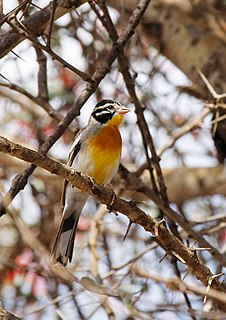Old World warblers are a large group of birds formerly grouped together in the bird family Sylviidae. The family held over 400 species in over 70 genera, and were the source of much taxonomic confusion. Two families were split out initially, the cisticolas into Cisticolidae and the kinglets into Regulidae. In the past ten years they have been the subject of much research and many species are now placed into other families, including the Acrocephalidae, Cettiidae, Phylloscopidae, and Megaluridae. In addition some species have been moved into existing families or have not yet had their placement fully resolved. A smaller family of warblers, together with some babblers formerly placed in the family Timaliidae and the parrotbills, are retained in a much smaller family Sylviidae.

The isabelline wheatear is a small passerine bird that was formerly classed as a member of the thrush family Turdidae, but is now more generally considered to be an Old World flycatcher in the family Muscicapidae. It is a migratory insectivorous bird. Its habitat is steppe and open countryside and it breeds in southern Russia and Central Asia to northern Pakistan, wintering in Africa and northwestern India. It is a very rare vagrant to western Europe.

The prairie warbler is a small songbird of the New World warbler family.

The southern pochard is a species of duck, and a member of the genus Netta. There are two subspecies, the South American (southern) pochard N. e. erythrophthalma and the African (southern) pochard N. e. brunnea.

The long-billed crombec or Cape crombec is an African warbler.

The yellow-necked spurfowl or yellow-necked francolin is a species of bird in the family Phasianidae. It is found in Djibouti, Eritrea, Ethiopia, Kenya, Somalia, Sudan, Tanzania, and Uganda. This species is named for the yellow patch found on its neck. Males of this species have been noted to have spurs on the back of their legs.

The Vanuatu megapode or Vanuatu scrubfowl is a species of bird in the family Megapodiidae. It was formerly known as the New Hebrides scrubfowl. It is found only in Vanuatu. Its natural habitat is subtropical or tropical moist lowland forest. The species is threatened by habitat loss and egg collecting.

The northern crombec is a species of African warbler, formerly placed in the family Sylviidae. It is found in Benin, Burkina Faso, Cameroon, Central African Republic, Chad, Democratic Republic of the Congo, Ivory Coast, Djibouti, Eritrea, Ethiopia, Gambia, Ghana, Guinea, Guinea-Bissau, Kenya, Mali, Mauritania, Niger, Nigeria, Senegal, Sierra Leone, Somalia, Sudan, Tanzania, Togo, and Uganda. Its natural habitat is dry savanna.

Sylvietta, the crombecs, is a genus of African warblers. Formerly placed in the massively paraphyletic Sylviidae, it is now considered to belong to a newly recognized family found only in Africa, Macrosphenidae.

The white-browed crombec is a species of African warbler, formerly placed in the family Sylviidae. The enigmatic Chapin's crombec might be a distinct species, or a subspecies Sylvietta leucophrys chapini of the present species.

Philippa's crombec, also known as the short-billed crombec, is a species of African warbler, formerly placed in the family Sylviidae. It is found in Ethiopia and Somalia. Its natural habitat is dry savanna.

The red-capped crombec is a species of African warbler, formerly placed in the family Sylviidae.

The green crombec is a species of African warbler, formerly placed in the family Sylviidae. It is widespread across the African tropical rainforest. Its natural habitats are subtropical or tropical moist lowland forests and subtropical or tropical moist shrubland.

The red-faced crombec is a species of African warbler, formerly placed in the family Sylviidae. It is found in Burundi, Ethiopia, Kenya, Malawi, Mozambique, Namibia, Rwanda, South Sudan, Tanzania, Uganda, and Zimbabwe. Its natural habitats are subtropical or tropical dry forests, subtropical or tropical moist montane forests, and subtropical or tropical dry shrubland.

The lesser hoopoe-lark is a species of lark in the family Alaudidae. It is endemic to Somalia where its natural habitat is subtropical or tropical dry lowland grassland.

The fire-breasted flowerpecker is a species of bird in the family Dicaeidae found in the Indian Subcontinent and Southeast Asia. Like other flowerpeckers, this tiny bird feeds on fruits and plays an important role in the dispersal of fruiting plants. Unlike many other species in the genus, this species has marked sexual dimorphism with the male having contrasting upper and lower parts with a distinctive bright orange breast patch. The female is dull coloured.

The Somali bunting or Somali golden-breasted bunting is a species of bird in the family Emberizidae.

The creamy-rumped miner is a species of bird in the family Furnariidae. It is found in Argentina and Chile. Its natural habitat is subtropical or tropical high-altitude grassland.

The red-fronted prinia, also known as the red-fronted warbler and the red-faced apalis, is a species of bird in the family Cisticolidae. It is found in Chad, Djibouti, Eritrea, Ethiopia, Kenya, Somalia, Sudan, Tanzania, and Uganda. Its natural habitat is dry savanna.

The African warblers are a newly erected family Macrosphenidae, of songbirds. Most of the species were formerly placed in the Old World warbler family Sylviidae, although one species, the rockrunner, was placed in the babbler family, Timaliidae. A series of molecular studies of the Old World warblers and other bird families in the superfamily Sylvioidea found that the African warblers were not part of Sylviidae but were instead an early (basal) offshoot of the entire clade Sylvioidea. Some taxonomic authorities place the entire family Hyliidae here.


















